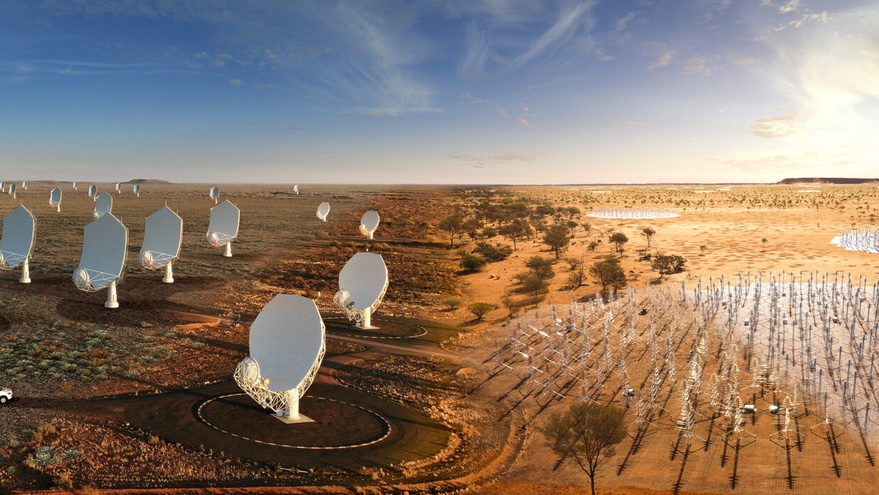
WASHINGTON — A multibillion-dollar radio telescope is moving into its construction phase while still working to raise funding and deal with satellite megaconstellations whose interference “change the game” for their plans.
In a June 29 talk at the annual meeting of the European Astronomical Society, Philip Diamond, director general of the Square Kilometer Array (SKA) Observatory, announced that the observatory’s council had formally approval plans to move into the construction phase of the radio telescope.
SKA is two separate facilities. SKA-Low, in Western Australia, will eventually be an array of more than 130,000 antennas performing observations at low frequencies. SKA-Mid will feature 197 dishes in South Africa for midrange radio frequencies, including 64 dishes of the existing MeerKAT array there.
The council’s decision allowed the SKA to move into its construction phase on July 1. “We won’t see shovels in the round on the first of July,” he said, but rather requests for proposal to build various aspects of the two facilities. The observatory expects that construction to be completed by 2029.
The SKA is designed to support a wide range of astronomy research, from studies of dark energy and pulsars to astrobiology. The concept for the SKA dates back three decades, when astronomers first considered concepts for a radio telescope that, as the name suggests, would span a square kilometer. Those concepts later evolved to the current design with facilities on two continents.
One technological challenge that has also evolved over that time is radio-frequency interference. “We radio astronomers have been used to dealing with the interference from satellites and aircraft systems,” Diamond said at a June 29 press briefing. “What the megaconstellations do is that they change the game for us.”
The difference is the sheer number of satellites, with proposals for potentially many tens of thousands of satellites. Many will be operating on frequencies that SKA-Mid, which operates between 350 megahertz and 15.3 gigahertz, is tuned to observe. While radio astronomy has priority for a few bands in that range, the satellites will be broadcasting — legally, he acknowledged — on many others.
Diamond said the SKA was in technical discussions with satellite operators on mitigation measures “that would significantly limit the impact on the SKA telescopes.” He didn’t elaborate on the specific measures.
During a talk at the conference July 2, Federico Di Vruno, spectrum manager of the SKA Observatory, said the observatory had developed “flagging and excision” technologies to identify radio-frequency interference by satellites and removing it from the data. “This represents a loss of observing time,” he said, but such interference from the constellations by OneWeb and SpaceX would account for less than four percent of observations.
However, he warned that even if the problem is manageable with those constellations, future systems would only increase the problem. That includes expansions of both OneWeb and SpaceX’s Starlink as well as the proposed Chinese Guowang constellation that could ultimately have 13,000 satellites.
“The prospect of constellations of tens of thousands of satellites is extremely concerning for radio astronomy,” he said. Operators, he suggested, could help by agreeing not to transmit when their satellites are passing over “radio quiet zones” surrounding the antennas.
The SKA faces a separate challenge: raising the funding needed to build the two facilities. The observatory estimates spending 2 billion euros ($2.4 billion) to build and operate the SKA over the next decade. Diamond said that the SKA Observatory, a multinational organization, was still working to raise the money from more than a dozen countries.
“We have raised the large majority of the required funding,” Diamond said, but declined to give a specific figure. “The members would not have been willing to go ahead with the decision to proceed with construction if they didn’t feel comfortable the requisite funds would flow.”
“We have some years in front of us to raise the additional funds that we need, which is very much a minority,” he said.
Notably absent from the SKA Observatory is the United States. Diamond said that American astronomers were involved in early planning for the radio telescope, and at one point the United States was expected to provide a third of the funding. However, the SKA did not emerge as a priority in the 2010 astrophysics decadal survey, where American astronomers instead selected other ground-based telescopes as more worthy of funding.
“The timing of the decadal survey didn’t align with the SKA timing,” he said. “The U.S. SKA activities did not get a high enough priority, so the U.S. funds were — unfortunately, from our perspective — directed to other highly deserving projects.”
American astronomers, he added, remain involved in SKA activities, including reviews. “It’s definitely not a divorce,” he said. “It’s just a fact of life from the 2010 decadal survey.”
Article From & Read More ( Radio telescope faces “extremely concerning” threat from satellite constellations - SpaceNews )https://ift.tt/3dHfXYC
Science
No comments:
Post a Comment